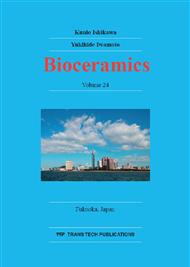[1]
Jha, R.K., Zi-rong, X. Biomedical Compounds from Marine organisms. Mar. Drugs 2, 123-146 (2004).
DOI: 10.3390/md203123
Google Scholar
[2]
Senni, K., Pereira, J., Gueniche, F., Delbarre-Ladrat, C., Sinquin, C., Ratiskol, J., Godeau, G., Fischer, A., Helley, D., Colliec-Jouault, S. Marine Polysaccharides: A Source of Bioactive Molecules for Cell Therapy and Tissue Engineering. Mar. Drugs 9, 1664-1681 (2011).
DOI: 10.3390/md9091664
Google Scholar
[3]
Miller D.J., Ball E.E., Technau, U. Cnidarians and ancestral genetic complexity in the animal kingdom Trends in Genetics 21, 536-539 (2005).
DOI: 10.1016/j.tig.2005.08.002
Google Scholar
[4]
Farre, B., Cuif, J.P., Dauphin, Y. Occurrence and diversity of lipids in modern coral skeletons. Zoology 113, 4, 250-257 (2010).
DOI: 10.1016/j.zool.2009.11.004
Google Scholar
[5]
Halvey S. In Microbiology: Applications in Food Biotechnology. Nga B.H.; Lu Y.K. Ed.; Elsevier Applied Science Press: New York, 1990; pp.123-134.
Google Scholar
[6]
Lelong, C., Mathieu, M., Favrel, P. Identification of new bone morphogenetic protein-related members in invertebrates. Biochimie 83, 423-426 (2001).
DOI: 10.1016/s0300-9084(01)01260-3
Google Scholar
[7]
Zoccola, D., Moya, A., Beranger, G.E., Tambutte, E., Allemand, D. et al. Specific expression of BMP2/4 ortholog in biomineralizing tissues of corals and action on mouse BMP receptor. Mar. Biotechnol. 11, 260-269 (2000).
DOI: 10.1007/s10126-008-9141-6
Google Scholar
[8]
Jackson, D.J., McDougall, C., Green, K., Simpson, F., Wörheide, G., Degnan, B.M. A rapidly evolving secretome builds and patterns a sea shell. BMC Biology 4, 1, 40 (2006).
DOI: 10.1186/1741-7007-4-40
Google Scholar
[9]
Seipel, K., Eberhardt, M., Muller, P., Pescia, E., Yanze, N. et al. Homologs of vascular endothelial growth factor and receptor, VEGF and VEGFR, in the jellyfish Podocoryne carnea. Develop. Dynamics 231, 303-312 (2004).
DOI: 10.1002/dvdy.20139
Google Scholar
[10]
Palmer C.V., Traylor-Knowles N.G., Willis, B.L., Bythell, J.C. Corals Use Similar immune cells and wound-healing processes as those of higher organisms. PLoS ONE 6, e23992 (2011).
DOI: 10.1371/journal.pone.0023992
Google Scholar
[11]
Nichols, S.A., Dirks, W., Pearse, J.S., King, N. Early evolution of animal cell signaling and adhesion genes. Proc. Natl. Acad. Sci. U.S.A. 103, 12451-12456 (2006).
DOI: 10.1073/pnas.0604065103
Google Scholar
[12]
Humphreys, T. Chemical and in vitro reconstitution of sponge cell adhesion. Isolation and functional demonstration of the components involved. Dev. Biol. 8, 27-47 (1963).
Google Scholar
[13]
Varner, J.A. Isolation of a Sponge-derived extracellular matrix adhesion protein. J. Biol. Chem. 271, 27, 16119-16125 (1996).
DOI: 10.1016/s0021-9258(18)48587-0
Google Scholar
[14]
Pancer, Z., Kruse, M., Muller, I., Muller, W.E.G. On the origin of metazoan adhesion receptors: cloning of integrin a subunit from the sponge Geodia cydonium. Mol. Biol. Evol. 14, 4, 391-398 (1997).
DOI: 10.1093/oxfordjournals.molbev.a025775
Google Scholar
[15]
Ehrlich, H. Multiphase biomineralization. In: Biological materials of marine origin-Invertebrates. Springer Science and Business Media B.V., 2010, pp.103-122.
Google Scholar
[16]
Kim, M-M., Mendis, E., Rajapakse, N., Lee, S-H., Kim, S-K. Effect of Spongin derived from Hymeniacidon sinapium on bone mineralization. J. Biomed. Maters. Res. B: Appl. Biomats. 90B, 2, 540-546 (2009). Bottom of Form.
DOI: 10.1002/jbm.b.31315
Google Scholar
[17]
Gautret, P., Cuif, J-P., Stolarski, J. Organic components of the skeleton of Sceleractinian corals- evidence from in situ acridine orange staining. Acta Palaentol. Pol. 45, 107-118 (2000).
Google Scholar
[18]
Allemand, D., Ferrier-Pagès, C., Furla, P., Houlbrèque, F., Puverel, S., Reynaud, S., Tambutté, E., Tambutté, S., Zoccola, D. Biomineralisation in reef-building corals: from molecular mechanisms to environmental control. C.R. Palevol. 3, 6-7, 453-467 (2004).
DOI: 10.1016/j.crpv.2004.07.011
Google Scholar
[19]
Atlan, G., Balmain, N., Berland, S., Vidal, B., Lopez, E. Reconstruction of human maxillary defects with nacre powder: histological evidence for bone regeneration. C.R. Acad. Sci. III. 320, 253-258 (1997).
DOI: 10.1016/s0764-4469(97)86933-8
Google Scholar
[20]
Mouriès, L.P., Almeida, M.J., Milet, C., Berland, S., Lopez, E. Bioactivity of nacre water-soluble organic matrix from the bivalve molluskPinctada maxima in three mammalian cell types: fibroblasts, bone marrow stromal cells and osteoblasts. Comp. Biochem. Physiol. B. Biochem. Mol. Biol. 132, 217-229 (2002).
DOI: 10.1016/s1096-4959(01)00524-3
Google Scholar
[21]
Almeida, M.J., Milet, C., Peduzzi J., Pereira, L., Haigle, J., et al. Effect of water-soluble matrix fraction extracted from the nacre of Pinctada maxima on the alkaline phosphatase activity of cultured fibroblasts. J. Exp. Zool. 15, 288, 327-334 (2000).
DOI: 10.1002/1097-010x(20001215)288:4<327::aid-jez5>3.0.co;2-#
Google Scholar
[22]
Oliveira, D.V., Silva, T.S., Cordeiro, O.D., Cavaco, S.I., Simes, D.C. Identification of proteins with potential osteogenic activity present in the water-soluble matrix proteins from Crassostreagigas nacre using a proteomic approach. Sci. World J. ID 765909 (2012).
DOI: 10.1100/2012/765909
Google Scholar
[23]
Pennington S.R., Wilkins M. R, Hochstrasser D.F., Dunn M.J. Proteome analysis: from protein characterization to biological function. Trends Cell Biol. 7, 168-173 (1997).
DOI: 10.1016/s0962-8924(97)01033-7
Google Scholar
[24]
Wilkins M.R., Sanchez J-C., Gooley A.A., Appel R.D., Humphrey-Smith I., Hochstrasser D.F., Williams K.L. Progress with proteome projects expressed by a genome should be identified and how to do it. Biotechnol. Genet. Eng. Rev. 13, 19-50 (1996).
DOI: 10.1080/02648725.1996.10647923
Google Scholar
[25]
Molloy, M.P., Witzmann, F.A. Proteomics: Technologies and applications. Brief Func. Gen. Proteo. 1, 23-39 (2002).
Google Scholar
[26]
Lottspeich, F. Proteome analysis: A pathway to the functional analysis of proteins. Angew. Chem., Int. Ed. 38, 2476-2492(1999).
DOI: 10.1002/(sici)1521-3773(19990903)38:17<2476::aid-anie2476>3.0.co;2-s
Google Scholar


